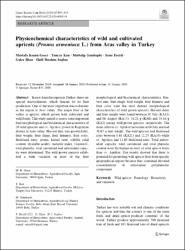| dc.contributor.author | Gecer, Mustafa Kenan | |
| dc.contributor.author | Kan, Tuncay | |
| dc.contributor.author | Gündoğdu, Muttalip | |
| dc.contributor.author | Ercişli, Sezai | |
| dc.contributor.author | İlhan, Gülce | |
| dc.contributor.author | Sağbaş, Halil İbrahim | |
| dc.date.accessioned | 2021-09-06T12:51:34Z | |
| dc.date.available | 2021-09-06T12:51:34Z | |
| dc.date.issued | 2020 | en_US |
| dc.identifier.citation | Gecer, M. K., Kan, T., Gundogdu, M., Ercisli, S., Ilhan, G., & Sagbas, H. I. (2020). Physicochemical characteristics of wild and cultivated apricots (Prunus armeniaca L.) from Aras valley in Turkey. Genetic Resources and Crop Evolution, 67(4), 935-945. | en_US |
| dc.identifier.issn | 0925-9864 | |
| dc.identifier.issn | 1573-5109 | |
| dc.identifier.uri | https://doi.org/10.1007/s10722-020-00893-9 | |
| dc.identifier.uri | https://hdl.handle.net/20.500.12899/391 | |
| dc.description.abstract | In east Anatolia region in Turkey, there are special microclimates, which famous for its fruit production. One of the most important microclimates in the region is Aras valley. The major fruit in the valley is apricot, which grown both cultivated and wild forms. This study aimed to assess some important fruit morphological and biochemical characteristics of 26 wild apricots and cv. Aprikoz grown in Kagizman district in Aras valley. Harvest date, tree growth habit, fruit weight, fruit shape, fruit firmness, fruit color, flesh/seed ratio, aroma, kernel taste, soluble solid content, titratable acidity, maturity index, vitamin C, total phenolic, total carotenoid and antioxidant capacity were determined. The wild grown apricots exhibited a wide variation on most of the fruit morphological and biochemical characteristics. Harvest date, fruit shape, fruit weight, fruit firmness and fruit color were the most distinct morphological characteristics of wild grown apricots. Harvest dates and fruit weight were found between 02 July (KA18) and 06 August (KA13); 16.28 g (KA6) and 33.14 g (KA2) among wild grown apricots, respectively. The main cultivar cv. Aprikoz harvested at 04 July and had 38.67 g fruit weight. The wild apricots had flesh/seed ratio between 8.41 (KA21) and 12.25 (KA10) while cv. Aprikoz had 11.69 flesh/seed ratio. Total antioxidant capacity, total carotenoid and total phenolic content were the highest in most of wild apricot fruits than cv. Aprikoz. Our results showed that there is potential for promoting wild apricot fruit from specific geographical regions because they contained elevated concentrations of antioxidant polyphenolic compounds. | en_US |
| dc.language.iso | eng | en_US |
| dc.publisher | Springer | en_US |
| dc.relation.isversionof | 10.1007/s10722-020-00893-9 | en_US |
| dc.rights | info:eu-repo/semantics/closedAccess | en_US |
| dc.subject | Wild apricot | en_US |
| dc.subject | Pomology | en_US |
| dc.subject | Bioactivity and variation | en_US |
| dc.title | Physicochemical characteristics of wild and cultivated apricots (Prunus armeniaca L.) from Aras valley in Turkey | en_US |
| dc.type | article | en_US |
| dc.authorid | 0000-0002-3584-5279 | en_US |
| dc.department | MTÖ Üniversitesi, Ziraat Fakültesi, Bahçe Bitkileri Bölümü | en_US |
| dc.contributor.institutionauthor | Kan, Tuncay | |
| dc.identifier.volume | 67 | en_US |
| dc.identifier.issue | 4 | en_US |
| dc.identifier.startpage | 935 | en_US |
| dc.identifier.endpage | 945 | en_US |
| dc.relation.journal | Genetic Resources and Crop Evolution | en_US |
| dc.relation.publicationcategory | Makale - Uluslararası Hakemli Dergi - Kurum Öğretim Elemanı | en_US |


















